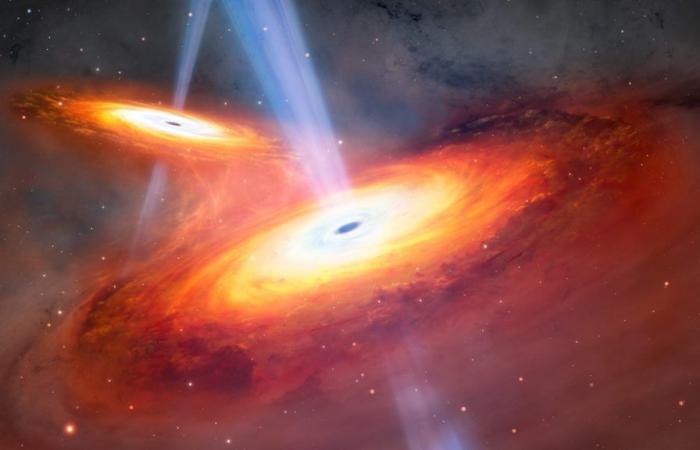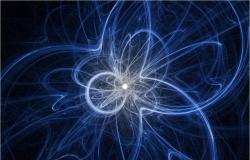
The universe is 13.8 billion years old and, in that time, countless things have happened, although, perhaps, at a rate that would surprise us. Some studies suggest that the first galaxies began when the universe was 50 million years old. We know the period from that moment to 1 billion years as the “Cosmic Dawn” and, now, after a long search, a group of scientists have managed to find the first pair of Cosmic Dawn quasars whose galaxies are They are merging. Something that, due to the size of the universe at that time and the number of galaxies that already existed, should be more frequent than observations suggest.
A quasar is an astronomical object whose name derives from “almost stellar object” because of how bright they shine in the night sky, appearing to be almost stars. Although, in reality, they are much larger, because they are supermassive black holes in the centers of galaxies that emit jets of light, as if they were lighthouses. With its great brightness and its relative frequency in a universe as primitive as that of that time, it is expected that scientists would have found quasars whose galaxies merged much earlier. Something didn’t fit. Is it possible that we are wrong with what we know about that time?
Of course it is possible, just as we can be wrong about hundreds of other scientific questions, especially when we are talking about the oldest and most distant fields of paleontology and cosmology. However, it seems that in this case the scarcity in our record of quasars whose galaxies were merging could be due to the fact that they are not, in fact, as bright as we had assumed. After observing this case, the researchers have concluded that part of the luminosity of these objects they have observed comes, logically, from the galaxies, and not only from the quasars in their nuclei.
This means that their galaxies are still forming new stars and that, between both disks, there is a gas bridge through which matter is exchanged, dragged by the gravity of the neighboring galaxy. In other words: observational evidence shows that, indeed, both galaxies are coming together. And, to give us an idea of this system of bodies… while the black hole at the center of our galaxy has a mass equivalent to 3 or 4 million suns, these two reach 100 million. A very interesting fact about this very ancient universe.
After studying the clues they had, the researchers were able to date this merger of galaxies when the universe was 900 million years old, this places it right at the end of the Cosmic Dawn, but, in turn, this era is divided into the Dark Ages, about which we know little and which lasted about 400 million years, and the Era of Reionization. The latter is called that because there were enough stars, galaxies and quasars emitting ultraviolet radiation, a very energetic type of light capable of tearing electrons from matter.
Those electrically charged particles that orbit around the nucleus of each atom. By losing them, the atoms take on a positive electrical charge and their surroundings take on a negative electrical charge, due to the loose electrons, we say that, then, the atom becomes ionized and that has given its name to the Era in question. During this time the great structures that we can observe in our universe appeared.
And that is why this discovery is so important, because, although about 300 quasars had been found in the Epoch of Reionization, none had been found in a pair. That was until Matsuoka and his team reviewed images taken with the Hyper Suprime-Cam on the Subaru Telescope and a faint red spot caught their attention. “While examining images of quasar candidates, I noticed two extremely red and similar sources next to each other,” Matsuoka said. “The discovery was purely fortuitous.”
Astronomer Yoshiki Matsuoka works at Ehime University in Japan and is the lead author of the paper describing these results, published in the journal Astrophysical Journal Letters. In his own words: “The statistical properties of quasars in the Epoch of Reionization tell us many things, such as the progress and origin of reionization, the formation of supermassive black holes during the Cosmic Dawn, and the earliest evolution of galaxies. hosts of quasars.
DON’T BE KNOWN:
- Although these are the first to be confirmed, there are more candidates from this time to be merging galaxy quasars. However, it is difficult to separate them from possible images of individual quasars due to gravitational lensing. Other candidate galactic nuclei have a luminosity much lower than that of a quasar, so they do not fit with what is described in this article.
REFERENCES (MLA):
- “Discovery of Merging Twin Quasars at z = 6.05” The Astrophysical Journal Letters 10.3847/2041-8213/ad35c7





